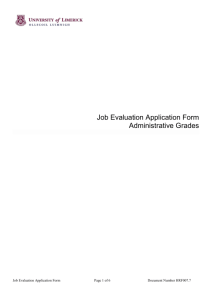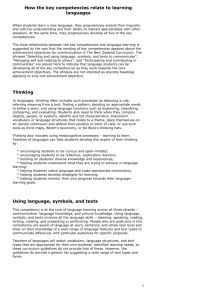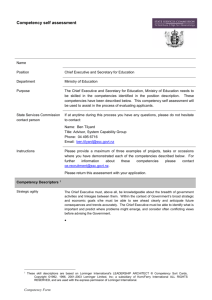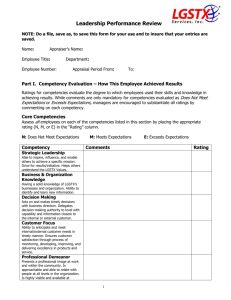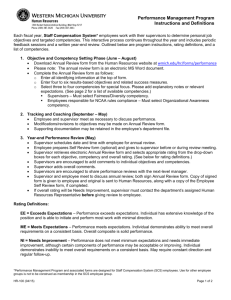FREE Sample Here
advertisement
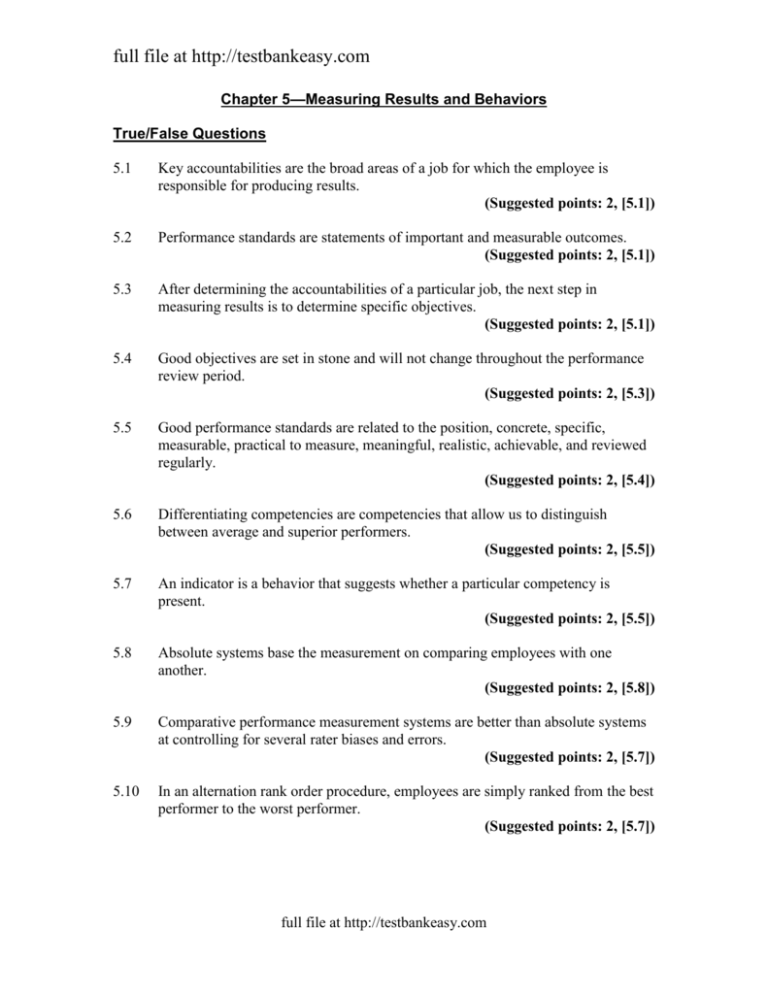
full file at http://testbankeasy.com Chapter 5—Measuring Results and Behaviors True/False Questions 5.1 Key accountabilities are the broad areas of a job for which the employee is responsible for producing results. (Suggested points: 2, [5.1]) 5.2 Performance standards are statements of important and measurable outcomes. (Suggested points: 2, [5.1]) 5.3 After determining the accountabilities of a particular job, the next step in measuring results is to determine specific objectives. (Suggested points: 2, [5.1]) 5.4 Good objectives are set in stone and will not change throughout the performance review period. (Suggested points: 2, [5.3]) 5.5 Good performance standards are related to the position, concrete, specific, measurable, practical to measure, meaningful, realistic, achievable, and reviewed regularly. (Suggested points: 2, [5.4]) 5.6 Differentiating competencies are competencies that allow us to distinguish between average and superior performers. (Suggested points: 2, [5.5]) 5.7 An indicator is a behavior that suggests whether a particular competency is present. (Suggested points: 2, [5.5]) 5.8 Absolute systems base the measurement on comparing employees with one another. (Suggested points: 2, [5.8]) 5.9 Comparative performance measurement systems are better than absolute systems at controlling for several rater biases and errors. (Suggested points: 2, [5.7]) 5.10 In an alternation rank order procedure, employees are simply ranked from the best performer to the worst performer. (Suggested points: 2, [5.7]) full file at http://testbankeasy.com 5.11 Behaviorally Anchored Rating Scales (BARS) include graphic rating scales that use critical incidents as anchors. (Suggested points: 2, [5.8]) 5.12 Forced distribution encourages teamwork and contextual performance behaviors and reduces competition within an organization. (Suggested points: 2, [5.7]) 5.13 The relative percentile method is a type of absolute performance measurement system. (Suggested points: 2, [5.7]) Multiple-Choice Questions 5.14 A(n) _____________ is a yardstick used to evaluate how well employees have achieved each objective. A. accountability B. results statement C. performance standard D. none of the above (Suggested points: 2, [5.1) 5.15 Characteristics of good objectives include all of the following EXCEPT: A. Specific and clear B. Spontaneous C. Challenging D. Bound by time (Suggested points: 2, [5.3]) 5.16 Which of the following characteristics can be used to judge the extent to which an objective has been achieved? A. Quality B. Quantity C. Time D. All of the above (Suggested points: 2, [5.4]) 5.17 ________________ are measurable clusters of KSAs that are critical in determining how results will be achieved. A. Objectives B. Competencies C. Performance standards D. None of the above (Suggested points: 2, [5.5]) 324 full file at http://testbankeasy.com 5.18 ___________ are competencies that each employee needs to display to do the job to a minimally adequate standard. A. Differentiating competencies B. Threshold competencies C. Distinguishing competencies D. None of the above (Suggested points: 2, [5.5]) 5.19 To understand the extent to which a competency is present, we measure _________. A. indicators B. performance standards C. objectives D. none of the above (Suggested points: 2, [5.6]) 5.20 ________________ systems base the measurement on comparing employees with a prespecified performance standard. A. Comparative B. Subjective C. Absolute D. Results (Suggested points: 2, [5.8]) 5.21 In this type of comparative system, employees are apportioned according to an approximately normal distribution. A. Simple rank order B. Paired comparisons C. Alternative rank order D. Forced distribution (Suggested points: 2, [5.7]) 5.22 All of the following are examples of absolute systems EXCEPT: A. Essay comparing the employee to other team members B. Essay identifying employee strengths and weaknesses C. Graphic rating scales D. Critical incidents (Suggested points: 2, [5.8]) 5.23 The use of _________________ ensure that the response categories are clearly defined, that interpretation of the rating by an outside party is clear, and that the supervisor and employee also understand the rating. A. essays B. graphic rating scales C. critical incidents D. all of the above full file at http://testbankeasy.com (Suggested points: 2, [5.8]) 5.24 Broad areas of a job for which the employee is responsible for producing results are called ___________________. A. responsibilities B. performance standards C. results D. key accountabilities (Suggested points: 2, [5.1]) 5.25 Statements of important and measurable outcomes are called _______________. A. key accountabilities B. performance standards C. objectives D. yardsticks (Suggested points: 2, [5.1]) 5.26 A yardstick used to evaluate how well employees have achieved each objective is called ____________________________. A. a performance standard B. a key accountability C. results D. responsibilities (Suggested points: 2, [5.1]) 5.27 Good objectives should have which of the following characteristics? A. Creativity B. Prioritized C. Open ended D. Set in stone (Suggested points: 2, [5.3]) 5.28 Which of the following is characteristic of good performance standards? A. Concrete B. Realistic C. Reviewed regularly D. All of the above (Suggested points: 2, [5.4]) 5.29 Competencies are composed of which of the following? A. Knowledge B. Abilities C. Skills D. All of the above (Suggested points: 2, [5.6]) 326 full file at http://testbankeasy.com 5.30 Differentiating competencies are: A. Those which allow us to distinguish between poor and average performers B. Those which allow us to distinguish between acceptable candidates and unacceptable candidates C. Those which allow us to distinguish between average and superior performers D. None of these is correct (Suggested points: 2, [5.5]) 5.31 Threshold competencies are: A. Those which allow us to see the threshold between good and poor performers B. Those which allow us to see the threshold between average and superior performers C. Those which must be attained in order to get an annual bonus D. Those which everyone must display in order to do the job at a minimally adequate level (Suggested points: 2, [5.5]) 5.32 What are the two types of systems used to evaluate competencies? A. Evaluative and Projective B. Comparative and Absolute C. Absolute and Evaluative D. Projective and Comparative (Suggested points: 2, .5[5.7], .5[5.8]) 5.33 All of the following are disadvantages of comparative systems EXCEPT: A. Competitive behaviors may become a problem B. Relative distance between employees’ performance is unclear C. Higher risk of leniency, severity, and central tendency biases D. Risk of legal issues (Suggested points: 2, [5.7]) 5.34 Use of simple rank order, alteration rank order, and relative percentile would be most appropriate in _____________ systems of evaluating competencies. A. declarative B. absolute C. projective D. comparative (Suggested points: 2, [5.7]) full file at http://testbankeasy.com 5.35 When raters are asked to consider all ratees at the same time and to estimate the relative performance of each by using a 100-point scale, which method are they using? A. Forced distribution B. Behaviorally anchored rating scales (BARS) C. Simple rank order D. Relative percentile (Suggested points: 2, [5.7]) 5.36 When supervisors select (in order) the best performer, then the worst performer, then the second best performer, then the second worst performer, and so forth, alternating between top and bottom until the list is completed (and they meet in the middle), they are using which measurement method? A. Paired comparisons B. Alternation rank order C. Random assignment D. Relative distance (Suggested points: 2, [5.7]) 5.37 Use of essays, critical incidents, and graphic rating scales would be most appropriate in a(n) ______________ system of evaluating competencies. A. declarative B. absolute C. projective D. comparative (Suggested points: 2, [5.8]) 5.38 Gathering reports of situations in which employees performed behaviors that were especially effective or ineffective in accomplishing their jobs is an example of __________________________________. A. a critical incident approach B. an essay approach C. a comparative approach D. a direct report approach (Suggested points: 2, [5.8]) Essay-Type Questions 5.39 Define and distinguish between accountabilities, objectives, and standards. Describe the critical steps in adopting a results approach to measuring performance. (Suggested points: 5, .25[5.1], .25[5.2], .25[5.3], .25[5.4]) 5.40 Explain the difference between absolute and comparative systems. What are the advantages and disadvantages to each type of system? (Suggested points: 5, .5[5.7], .5[5.8]) 328 full file at http://testbankeasy.com 5.41 Discuss the questions that one must be able to answer when adopting a results approach. (Suggested points: 2, [5.1]) 5.42 Explain why accountabilities are determined. (Suggested points: 2, [5.2]) 5.43 List the characteristics of good objectives. (Suggested points: 2, [5.3]) 5.44 List the four characteristics necessary of a useful standard, and give an example of each characteristic using the following standard as an example: Increase sales from $15,000 to $22,000 by December 1st at a cost not to exceed $3,000. (Suggested points: 2, [5.7]) 5.45 Explain the difference between a threshold competency and a differentiating competency. (Suggested points: 2, [5.2]) 5.46 Discuss the three aspects of specific objectives that can be used to judge the extent to which an objective has been achieved. (Suggested points: 3, [5.3]) 5.47 List the characteristics of good performance standards. (Suggested points: 2, [5.4]) 5.48 To understand the extent to which an employee possesses a competency, we measure indicators. Explain the term indicator. (Suggested points: 2, [5.6]) 5.49 List the components that must be present when describing a competency. (Suggested points: 2, [5.6]) 5.50 Identify and explain five comparative measurement systems. (Suggested points: 3, [5.8]) 5.51 Describe the advantages and disadvantages of using the various absolute evaluation approaches. (Suggested points: 3, [5.8]) full file at http://testbankeasy.com Answers 5.1 5.2 5.3 5.4 5.5 5.6 5.7 5.8 5.13 T F: Objectives are statements of important and measurable outcomes. T F: Good objectives are flexible. T T T F: Comparative systems base the measurement on comparing employees with one another. T F: In a simple rank order system, employees are simply ranked from the best performer to the worst performer. T F: A forced distribution method may discourage contextual performance behaviors and teamwork and may increase competition within an organization. F: Relative percentile is a type of comparative performance measurement system. 5.14 5.15 5.16 5.17 5.18 5.19 5.20 5.21 5.22 5.23 5.24 5.25 5.26 5.27 5.28 5.29 5.30 5.31 5.32 5.33 5.34 5.35 5.36 5.37 5.38 C B D B B A C D A B D C A B D D C D B C D D B B A 5.9 5.10 5.11 5.12 330 full file at http://testbankeasy.com 5.39 Key accountabilities are broad areas of a job for which the employee is responsible for producing results. Objectives are statements of important and measurable outcomes. Finally, a performance standard is a yardstick used to evaluate how well employees have achieved each objective. Performance standards provide information on acceptable and unacceptable performance regarding, for example, quality, quantity, cost, and time. The first step in determining accountabilities is to collect information about the job. Tasks included in the job description can be grouped into clusters of tasks based on their degree of relatedness. Each of these clusters or accountabilities is a broad area of the job for which the employee is responsible for producing results. Once the accountabilities are identified, we need to determine their relative degree of importance and specific objectives. The purpose of establishing objectives is to identify a limited number of highly important results that, when achieved, will have a dramatic impact on the overall success of the organization. After objectives are set, employees should receive feedback on their progress toward attaining the objective, and rewards should be allocated to employees according to whether they have reached their objectives. Once accountabilities and objectives have been determined, the next step is to define performance standards. Standards can refer to various aspects of a specific objective including quality, quantity, and time. 5.40 Comparative systems base the measurement on comparing employees with one another. Advantages of using relative measurement methods include: these types of measurement procedures are usually easy to explain, decisions resulting from these types of systems are fairly easy and cut and dry, and they tend to control for several biases and errors made by those rating performance better than absolute systems. Disadvantages associated with the use of relative systems include: employees usually are compared only in terms of a single overall category, and we don’t have information on the relative distance between employees. Absolute systems base the measurement on comparing employees with a prespecified performance standard. Advantages of using absolute systems include: the essay system has the potential to provide detailed feedback to employees regarding their performance, behavior checklists are easy to use and understand, and critical incidents allow supervisors to focus on actual job behavior rather than on vaguely defined traits. Disadvantages of using absolute systems include: essays are almost totally unstructured, detailed and useful feedback is difficult to extract from the numerical rating provided by a behavior checklist, and collecting critical incidents is very time consuming. 5.41 When adopting a results approach, one must be able to answer the following questions: What are the different areas in which this individual is expected to focus his/her efforts (key accountabilities)? Within each area, what are the expected objectives? full file at http://testbankeasy.com How do we know how well the results have been achieved (performance standards)? 5.42 Accountabilities are determined to identify a limited number of highly important results that, when achieved, will have a dramatic impact on the overall success of the organization. 5.43 Good objectives have the following characteristics. They are: Specific and clear Challenging Agreed upon Significant Prioritized Bound by time Achievable Fully communicated Flexible Limited in number 5.44 Standards must include an action (increase), the desired result (to $22,000), a due date (by December 1st), and some type of quality or quantity indicator (the increase in sales from $15,000 to $22,000 and at a cost not to exceed $3,000). 5.45 There are two types of competencies: differentiating and threshold. Differentiating competencies are those that allow us to distinguish between average and superior performers. Threshold competencies are those that everyone needs to display to do the job at a minimally adequate standard. In other words, the difference is that threshold competencies are essential in order to perform a job, whereas differentiating competencies will distinguish the top performers from the rest. 5.46 When judging the extent to which an objective has been achieved, the following three aspects of the specific objective should be considered in comparison to what was expected: Quality—in terms of how well the objective was achieved Quantity—in terms of how much of the objective was achieved, how many objectives were achieved, how often the objective was achieved, and at what cost the objective was achieved Time—in terms of due dates, the schedule, cycle times, and how quickly the objective was achieved 5.47 Good performance standards have the following characteristics. They are: Related to the position Concrete, specific, and measurable Practical to measure Meaningful 332 full file at http://testbankeasy.com Realistic and achievable Reviewed regularly 5.48 An indicator is an observable behavior that gives us information regarding the competency in question. 5.49 When describing a competency, we need to provide the following components: Definition of a competency Description of specific behavioral indicators that can be observed when someone demonstrates a competency effectively Description of specific behaviors that are likely to occur when someone doesn’t demonstrate a competency effectively (what a competency is not) Suggestions for developing the competency 5.50 Comparative measurement systems are as follows: A. Simple rank order is simply when employees are ranked from best performer to worst performer. B. Alternation rank order is when the supervisor selects (in the following order) the best performer (i.e., #1), then the worst performer (e.g., #2000), then the second best performer (i.e., #2), then the second worst performer (e.g., #1999), and so forth, alternating between top and bottom until the list is completed (and they meet in the middle). C. Paired comparisons are when explicit comparisons are made between all pairs of employees to be evaluated, such that each employee’s performance is compared to all other employees’ performance. D. Relative percentile method asks raters to consider all ratees at the same time and to estimate the relative performance of each by using a 100-point scale. If an employee receives a 75-point mark on the scale, it means that about 25 percent of employees are better performers and about 75 percent of employees are worse performers than this individual. This method may include one such scale for each competency as well as one scale to evaluate the overall performance of all employees. E. Forced distribution apportions employees according to an approximately normal distribution. For example, about 20 percent will fall under the “top performers” category, about 70 percent will fall under the “average performers” category, and about 10 percent will fall under the “underperformance” category. 5.51 Absolute performance measurement systems compare employees with prespecified performance standards, using the following approaches: A. Essays describe the employee’s strengths and weaknesses, making suggestions for improvement. An advantage is that essays have the potential to provide detailed feedback; disadvantages to essays include the fact that they are unstructured and may lack detail, their usefulness depends on the supervisor’s writing skill, and they are difficult to use in decisions regarding compensation, partially due to the lack of quantitative information provided. full file at http://testbankeasy.com They are also quite time consuming, considering the number of employees the supervisor may have. B. Behavior checklists use a form listing behavioral statements that are indicators of the various competencies to be measured. An advantage is that such a checklist is easy to understand; disadvantages are that the scale points used are often arbitrary and that it is difficult to get detailed and useful feedback from the numerical rating. C. Critical incidents: This approach involves gathering reports of situations in which employees performed behaviors that were especially effective or ineffective in accomplishing their objectives. An advantage is that this allows the supervisor to focus on actual employee behavior rather than on vaguely defined traits; the disadvantage is that collecting such information is very time consuming. D. Graphic rating scales are considered the most popular tools to measure performance. It is important to ensure that the response categories are clearly defined, that interpretation of the rating by an outside party is clear, and that the employee and the supervisor would both understand the rating. Behaviorally Anchored Rating Scales (BARS) improve on graphic rating scales by using critical incidents as anchors. Their development is dependent on active employee involvement at several points as well as final supervisor and employee checking of the items for dependability of the ratings. 334

